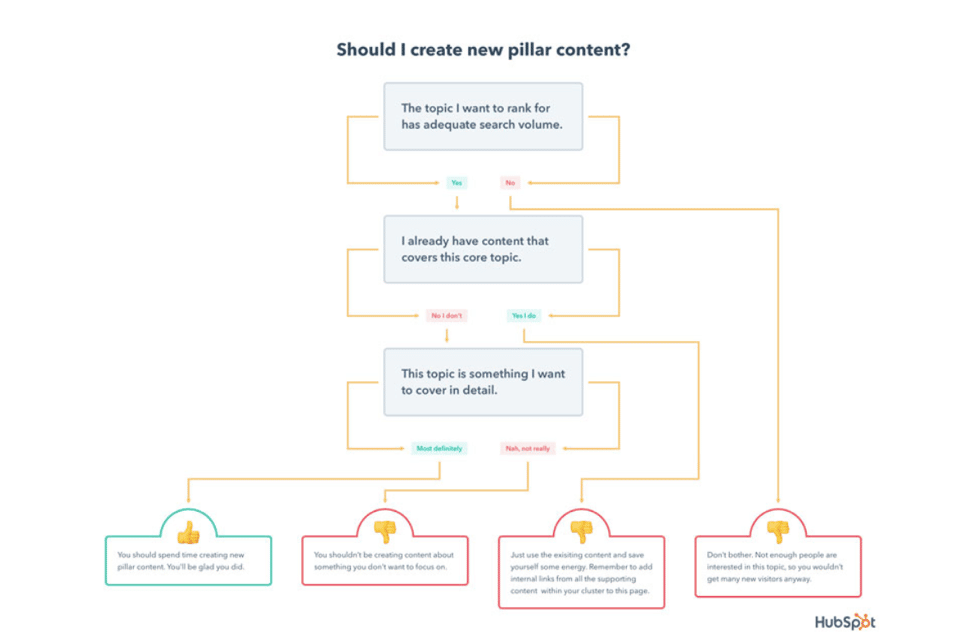Developing high-quality content should be a top priority for many businesses that want to drive more traffic, leads, and sales. A way in which this can happen is to expand the lifecycle of content topics and assets that have high engagement.
Developing content clusters can help you to achieve this. But why content clusters?
Hubspot dives into detail about the driving forces behind the changing landscape of online marketing in their article “The Future of Content Strategy,” but the basic idea is that:
- Search Engines are Changing: As Google has developed new algorithms, marketers have to shift their idea that keyword rankings are the main driver of visibility. “Depending on how and where you’re searching from, you’ll see different search results, which makes it difficult to evaluate success based on keyword rankings alone.” – Matt Barby, Head of Growth and SEO at HubSpot
- The Searcher is Changing: People are asking more complex questions in an increasingly conversational manner by using mobile and voice searches. This makes it more difficult to narrow down prime “keywords” to include in content.
SEO is changing, but it is not dead. The idea is to change your perspective on how your content needs to be strategized, structured and created in order to use SEO to drive more traffic, leads, and sales.
These changes answer the question “but why content clusters?” In order for a business to increase their visibility and achieve their conversion goals, marketers must understand how their ideal customers are searching for answers and how Google is ranking which answer will appear first.
So, how can you adapt your content marketing strategy to overcome the current challenges faced on the content/SEO landscape to expand the lifecycle of content topics and assets that have high engagement?
Create Content Pillars
A Content Pillar is an overarching topic that individual pieces of content will be categorized under to create content clusters. You will use these pillars to create an entire page on your website that is dedicated to this topic.
Divide your content into content pillars by:
- Reviewing your existing content: Your current content has already been created for your ideal consumers and therefore you likely already have content that can be placed together in a pillar. For example, if you’re in the business of selling workout machinery and your ideal customer searches for new workout routines regularly, then you’ve likely already created articles such as “workout routines to get abs” and “workout routines to lose fat.” This content should be repurposed into a content pillar.
- Review your existing content’s performance: High performing pieces of content are a good indication of a topic that should be made into a content pillar. For example, if one of your highest performing pieces of content is “workout routines at home” then this subject has the potential to be created into a content pillar that includes sub-topics such as “leg workout routines at home” or “ab workout routines at home.”
- Review Existing Customer Problems: I’m sure you’ve done plenty of research about the questions and problems that your ideal customers are facing, but I’m going to tell you to do more! Evaluate your FAQs, conduct interviews, etc., but with the idea that you can group these problems into a pillar. For example, if you’re ideal customers are having problems staying motivated while working out at home, create the content pillar “How to Stay Motivated While Working Out at Home” with sub-topics such as “10 Tips for Staying on Track During Your 30-Day Ab Challenge.”
Before diving into the next step, check to see if each content pillar is worth fleshing out. Not every pillar you brainstorm will be worth the time and effort. HubSpot includes this handy guide for whether or not you should create a content cluster.
Create Content Clusters
This is what makes up a content cluster: subtopics that relate to one another and also relate to one overarching idea to create a content pillar that search engines view as authoritative and comprehensive.
This is where SEO makes its way back to your content strategy. However, instead of searching for keywords that relate to a single article, search for keywords that relate to an entire content pillar. Then turn these keywords in content that can be clustered under your content pillar.
Referring back to our previous example, keywords that relate to the content pillar “How to Stay Motivated While Working Out at Home” include “workout plans” and “reward systems.” These two keywords can be turned into sub-topics such as “A Workout Plan to Help You Stay on Track” and “Our 3-Step Reward System to Help Keep You Motivated While Working Out at Home.”
Further, consider exploring topics that Google suggests when you type in a content pillar. For example, when I type in “how to stay motivated while working out at home,” topics such as “how do I stay motivated to eat healthily” also come up. This is a concept that can be included with the content pillar “how to stay motivated to workout at home.” Also check out tools like Buzzsumo to help you find topics that are trending in your industry.
Interlink
Interlinking will show search engines that you have in fact created content clusters that are related to one another. Furthermore, it will guide your ideal customers through the buying stages and ideally convert them into traffic, leads, sales, etc.
Do so by: Linking your content clusters to your pillar pages and your pillar pages to your content clusters; linking your sub-topics to one another; and cross-referencing from one sub-topic to another by linking to the article directly or by using related keywords.
Analyze, Analyze, Analyze
Tracking and analyzing is an important last step in creating a successful content marketing strategy using content clusters.
Do so by: Linking your clusters to a campaign; promoting your content via social media, email paid ads, etc. and tracking their results; and using analytical tools that track domain authority, monthly search volume, relevancy, core topic similarity, and other metrics.
If you see that a specific pillar is doing well, broaden it to make it an even more in-depth category. If you see that a pillar is doing poorly, try fitting the sub-topic underneath another pillar or analyze whether or not your ideal audience truly values the information being shared.







3 Responses